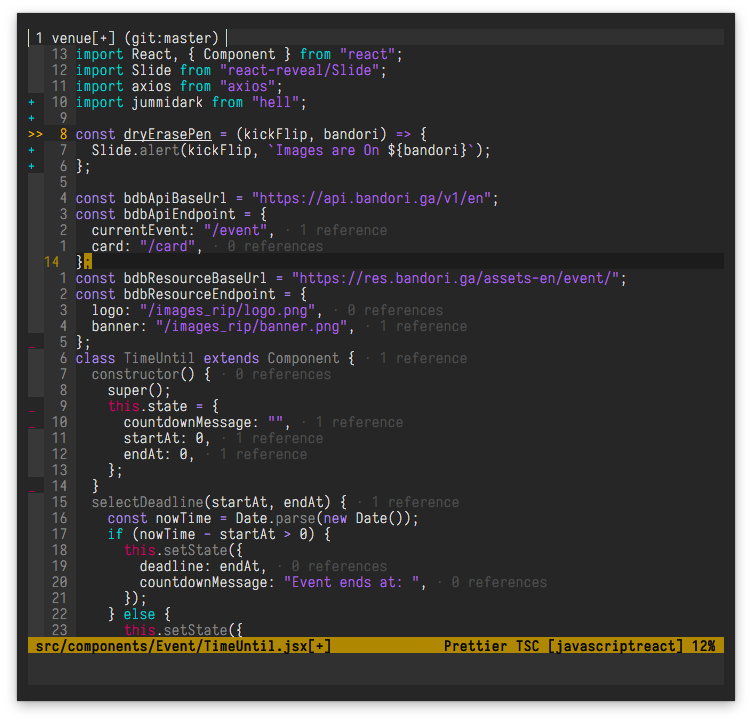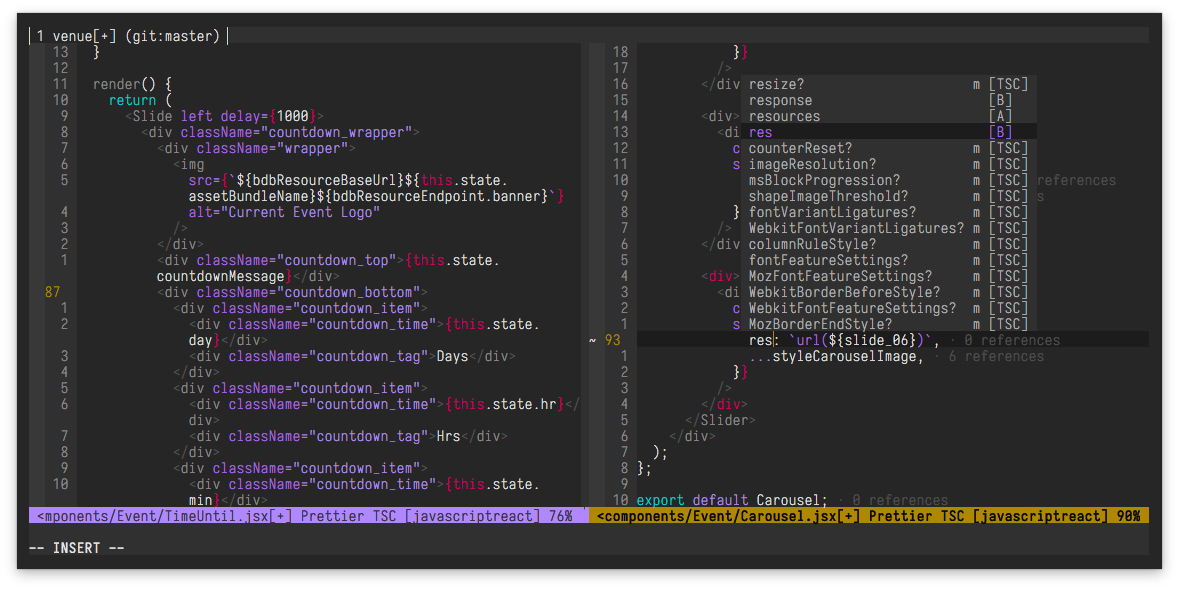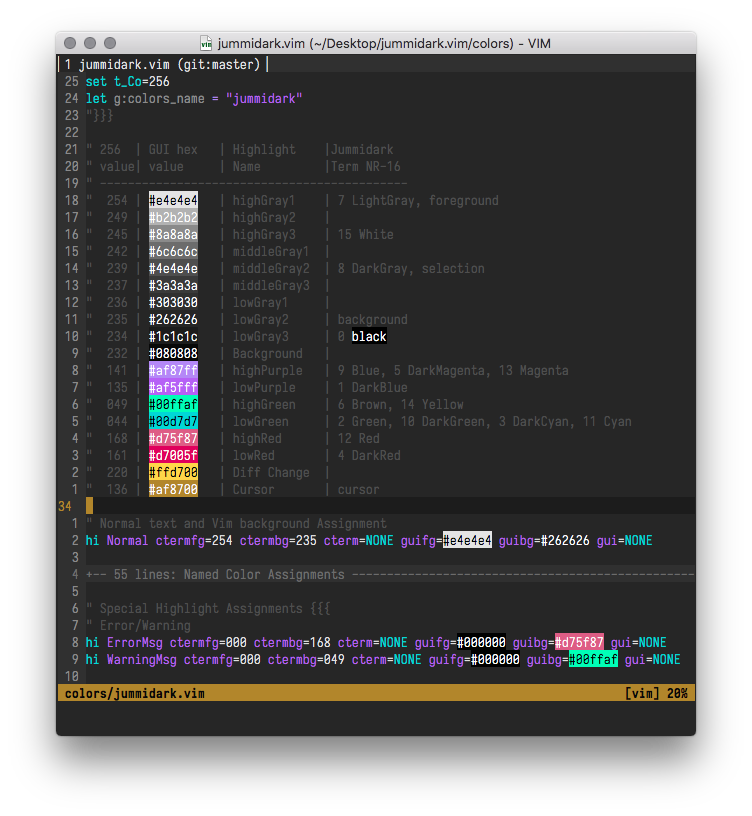It's just a vim colorscheme forked from original work by kamykn's dark-theme.vim.
Shown here: NeoVim with coc.nvim, taboo.vim, and the native statusline; javascript/jsx in 14pt Iosevka; highlighting with vim-polyglot.


There are a lot of considered design principles in jummidark but I won't go into it because it's just a colorscheme. I think the most important things are that this only uses terminal-safe colors, and there aren't too many of them.
This fork adds:
If using neovim, active window is indicated by background color- Currently this is commented out because I'm not proud of how it's done and it's been brought to my attention that people are actually using this thing
- Native statusbar colors for users who don't use plugins like Airline, Powerline, etc.
- Tabline, tab, and border colors that make split boundaries more clear
- Cursor, cursorline, and number column colors
- Visual mode selection colors
- Legible Pmenus in NeoVim
- Visually distinguished message/cmd area background
- A no-background scheme (jummidark-nobg) for users of custom terminal themes that have window transparency or custom color.
- An experimental light theme with adjusted colors.
- Language specific changes:
- Highlighting of HTML and JSX attribute values are adjusted for differentiation
A plugin manager like vim-plug is recommended. In vim-plug for example, add the following to your plugin call:
Plug 'jcherven/jummidark.vim'Reload your config file while it's open with :source %, or simply restart vim. You can then try it out temporarily in the active vim session with :colo jummidark.
To persist the new colorscheme, in your ~/.vimrc or ~/.config/nvim/init.vim add:
syntax enable
colorscheme jummidarkThere's also a WIP light theme included called jummilight. It's not as polished as the dark one. I poke at it every few months when I switch to light themes for no reason.
Included is a separate jummidark-nobg which sets the Normal background to NONE. If you're using a custom terminal background that uses transparency or a color that you prefer, setting this one as colorscheme will let that work properly.
The comments of the jummidark script contains a color key with hex and 256 values for adapting a terminal color scheme as well. I've included my personal color choices for my terminal's NR-16 color definitions.
|LIGHT |DARK
| 256 | GUI hex | Highlight | || 256 | GUI hex | Highlight |Jummidark
| value| value | Name | || value| value | Name |Term NR-16
|---------------------------------| -----------------------------------------------------
| 254 | #e4e4e4 | highGray1 | background || 254 | #e4e4e4 | highGray1 | 7 LightGray, foreground
| 252 | #d0d0d0 | highGray2 | || 252 | #d0d0d0 | highGray2 |
| 249 | #b2b2b2 | highGray3 | || 249 | #b2b2b2 | highGray3 |
| 245 | #8a8a8a | highGray4 | selection || 245 | #8a8a8a | highGray4 | 15 White
| 242 | #6c6c6c | middleGray1 | || 242 | #6c6c6c | middleGray1 |
| 239 | #4e4e4e | middleGray2 | || 239 | #4e4e4e | middleGray2 | 8 DarkGray, selection
| 237 | #3a3a3a | middleGray3 | || 237 | #3a3a3a | middleGray3 |
| 236 | #303030 | lowGray1 | || 236 | #303030 | lowGray1 |
| 235 | #262626 | lowGray2 | foreground || 235 | #262626 | lowGray2 | background
| 234 | #1c1c1c | lowGray3 | || 234 | #1c1c1c | lowGray3 | 0 black
| 232 | #080808 | Background | || 232 | #080808 | Background |
| 135 | #af5fff | highPurple | || 141 | #af87ff | highPurple | 9 Blue, 5 DarkMagenta, 13 Magenta
| 93 | #8700ff | lowPurple | || 135 | #af5fff | lowPurple | 1 DarkBlue
| 44 | #00d7d7 | highGreen | || 049 | #00ffaf | highGreen | 6 Brown, 14 Yellow
| 30 | #008787 | lowGreen | || 044 | #00d7d7 | lowGreen | 2 Green, 10 DarkGreen, 3 DarkCyan, 11 Cyan
| 168 | #d75f87 | highRed | || 168 | #d75f87 | highRed | 12 Red
| 161 | #d7005f | lowRed | || 161 | #d7005f | lowRed | 4 DarkRed
| 220 | #ffd700 | Diff Change | || 220 | #ffd700 | Diff Change |
| 165 | #d700ff | Cursor | cursor || 136 | #af8700 | Cursor | cursor
